Electric heated towel rails for the bathroom: varieties, selection, installation

There are many tools for creating bathroom amenities. The heated towel rail is one such accessory that has many functions.

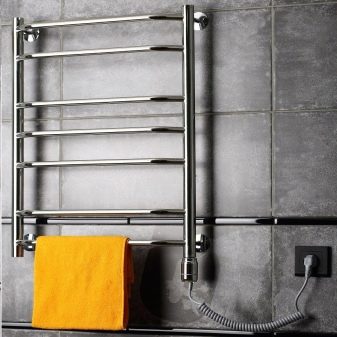
Advantages and disadvantages
One of the most important advantages of an electric heated towel rail for a bathroom is its versatility. In addition to its direct purpose - a dryer for clothes and towels, it can function as a conventional heater. By heating the bathroom, it thereby protects against the formation of condensation and moisture, which means mold and mildew.
An electric heated towel rail also has such advantages.
- Economical operation. With the consumption of a minimum amount of electricity, the power of the device is sufficient to heat the bathroom. It consumes almost as much electricity as an ordinary 25-100 W bulb.
- Tightness of the structure and durability of operation... Unlike water appliances, which corrode over time and form leaks, electric models are devoid of such a drawback, therefore, they serve for a long time.
- Autonomy of work. These devices do not depend on the pressure in the water supply system and a long cut-off of the water, since they operate on electricity, which is turned off extremely rarely.
- Mobility. Since heated towel rails are not tied to the plumbing system or heating, you can install them anywhere, and also change the location if necessary.
- Easy installation. The devices are installed using fasteners; you can install them yourself.
- Disconnectable and easy to adjust heating intensity.
- Uniform heating up to a certain temperature.
- Variety of design... This makes it possible to match the model to any interior of the room, and individual models can truly decorate the bathroom.
- A large assortment models of different sizes and shapes.
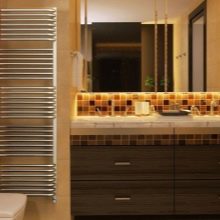

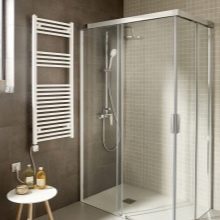
In addition, many models are equipped with electronic control mechanisms and have several modes of operation.
The disadvantages of the devices are the following:
- devices require an individual power line and may require the installation of an additional outlet;
- although small, but additional power consumption;
- there are certain requirements for the installation of the device and the need to comply with the rules of its operation.
Often breakdowns occur precisely because of non-compliance with these requirements. However, they are quickly detected, and many of them can be fixed on your own.
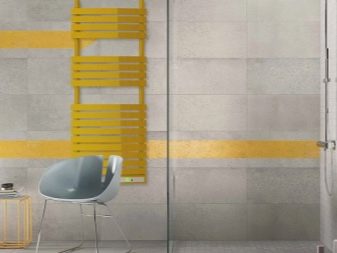
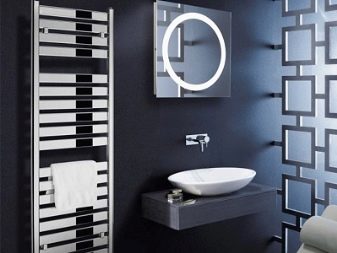
Views
Heated towel rails can have different designs, technological parameters, mounting methods. This device is a simple device made of metal tubes and a heating element that is connected to the power supply. Heated towel rails are classified according to several criteria.
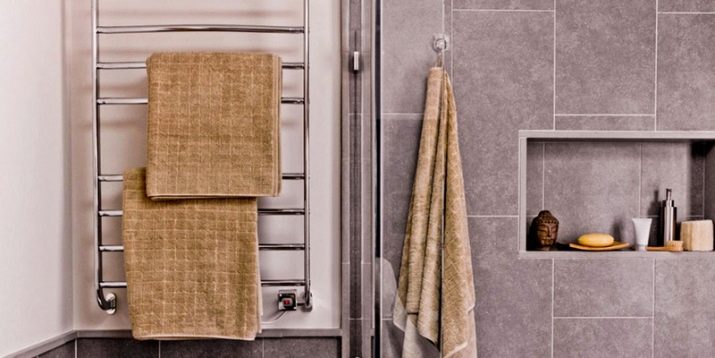
Heating type
- Dry species, or cable ones, are heated using a cable located inside the device, which heats the air and the walls of the tubes. They heat up very quickly, in almost 15-20 minutes, reaching the maximum temperature level, but they also cool down quickly. They are characterized by low power consumption. Dry models are used mainly for drying clothes, but they do not have enough power to heat them.
These devices can be modified with a "dry" type heating element: in them, the gap between the heating element and the walls of the tubes is filled with compacted sand.

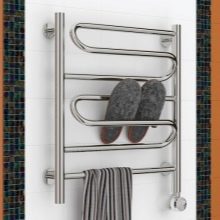
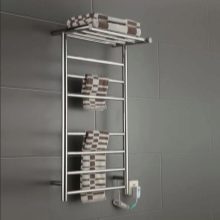
- Liquid or wet. They use as a coolant:
- Water - such devices can heat up to 85 degrees, and after turning off they quickly cool down;
- mineral oil - the heating time of such models is much longer (about 1 hour), but they retain heat for a long time and cool down for a long time after turning off;
- antifreeze - these models have a high thermal conductivity.
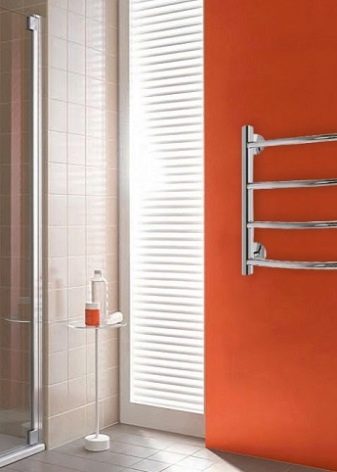
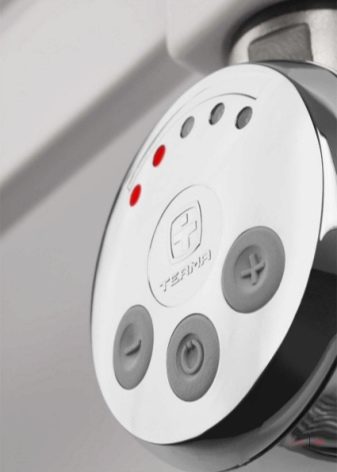
Mounting type
- Wall models. This type of appliance is attached to the wall and is the best option for small bathrooms, since it makes it possible to save room space.
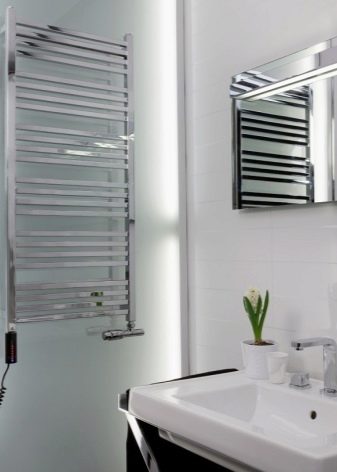
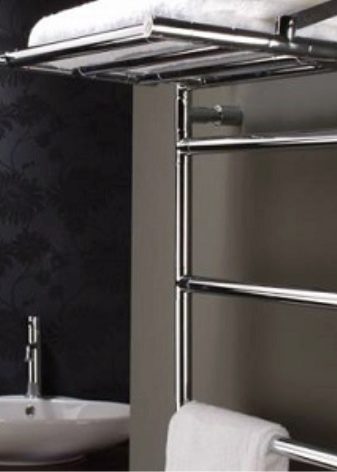
- Outdoor devices. They are most often installed in spacious rooms. These models perform the functions of drying things and heating the room. Their installation is very simple: they are installed on the floor in the right place and connected to the power supply. If necessary, they can be easily rearranged to another place.
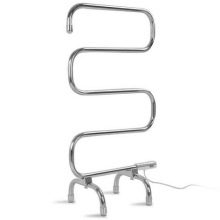
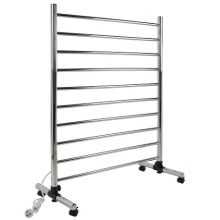
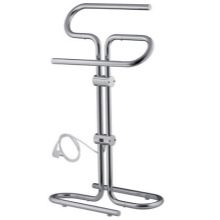
Devices can be with or without a thermostat. The thermostat makes it possible to independently determine the temperature regime of heating the surface of the tubes. It is a disc either with divisions or with an indication of temperature. When the set temperature is reached, the heating element automatically turns off and turns on again when the temperature drops by 1 degree from the set one. The thermostat makes it possible to select the desired operating mode, avoiding overheating and high consumption of electricity.
Devices without thermostat equipped with a thermocouple, which is also able to turn off the heating when the set temperature is reached.
The difference lies in the impossibility of changing the temperature indicator at will, since the device has a factory set temperature maximum.
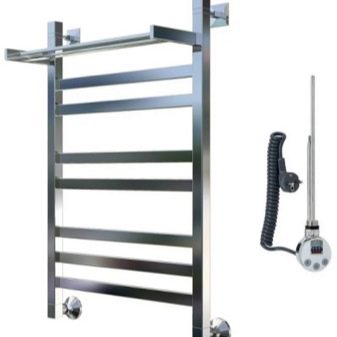
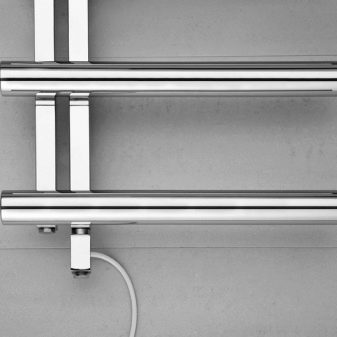
Shapes and sizes
Heated towel rails can also vary in shape and size. In form, they are classic, in the form of a ladder and designer. Models of the classical type are simple designs in the form of letters C, P, M, E, S, U, as well as in the form of a zigzag and a snake, the so-called coil. Heated towel rails of these forms were the first to appear and have been around for a very long time. Devices of such forms are practical, they are compact in size, they take up little space. Currently, you can see combined models - foxtrots, consisting of 2 coils: external U-shaped and internal in the form of a zigzag.
A ladder is a structure consisting of 2 supports held together by several crossbeams. They have a large heat transfer surface. Hollow tubes with a cable or heat carrier can be used as crossbars. Often the bars are metal plates, which further increases the heat transfer surface. Things on the ladders dry out quickly, as they warm up completely.
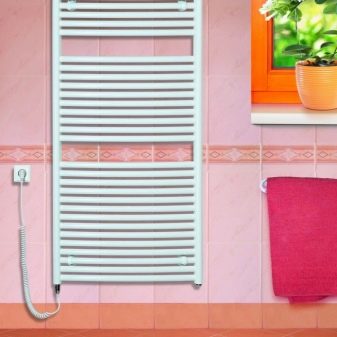
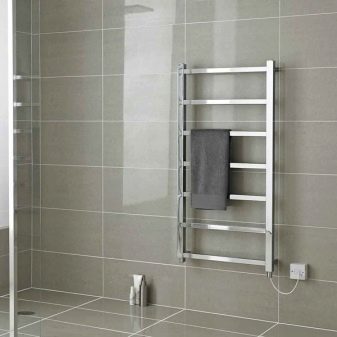
Designed models can have the most unusual original shape.... The sizes of the devices are also very different. Not only the efficiency of the device depends on the dimensions, but also the beauty of the interior of the room.
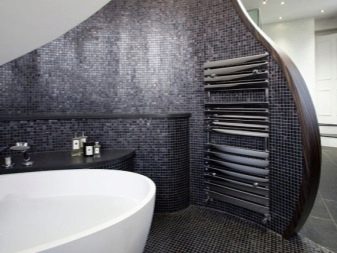

U-shaped models are the most compact: their height is usually 32 cm, width - in the range of 40-80 cm. By the ladders the dimensions are slightly larger - the height is from 0.5 m to 1.2 m with a width of 50-80 cm. M-shaped models They are distinguished by a beautiful appearance, their height corresponds to 50-60 cm with a width of 40-80 cm. Foxtrot height can be from 32 to 60 cm, width - from 40 to 80 cm.
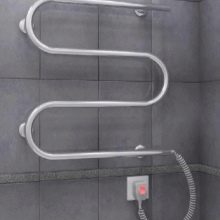
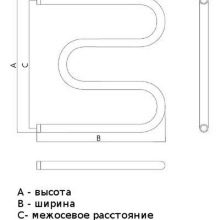

Materials (edit)
Electric heated towel rails can be made of various materials: structural (black) steel, stainless steel and non-ferrous metals. Black steel is the cheapest material... The tubes are coated with an anti-corrosion compound inside, and outside they are coated with paint or a layer of chrome or nickel plating. Usually, dry-type models are made of such material using a cable or dry heating element. The disadvantage of such devices is their fragility, since black steel is quickly damaged.
Stainless steel products are considered versatile and will be appropriate in any bathroom. They are reliable and have a long service life. Such models are processed by polishing, applying a chrome layer or painting.

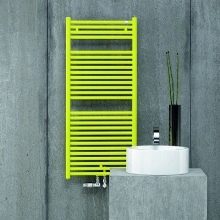
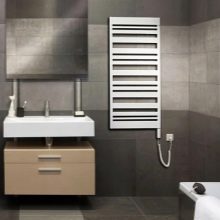
Painted models quickly lose their original appearance. These are the cheapest devices.
Polished and chrome plated are more expensive but have a longer lifespan. They usually have a shiny surface and look beautiful in the interior.
Copper, brass and bronze are usually used for the manufacture of models with an original design. Products made from them have a more beautiful aesthetic appearance. They are characterized by fast heating and long heat retention. Compared to brass appliances, copper models are the most practical and durable. However, both copper and brass devices require special care. To maintain their beautiful appearance, regular polishing of the product surface is required.

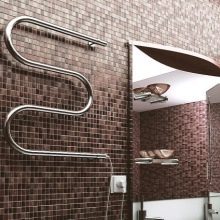
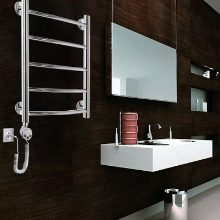
Design
Design models include those that differ in form from the classic ones, their design can be very diverse. They use various decorative elements, such as figures of animals, fish or flowers, silhouette screens, lattice plates. They can be stationary and rotary, with rotating sections that are conveniently installed at different angles.
Models in the form of a set of interconnected hexagons are very fashionable now. Such products are large enough and are suitable only for spacious rooms. Some appliances have built-in mirrors. Designer models can be of different colors: black, bronze, gold and silver. Such products often serve as decoration for a room.

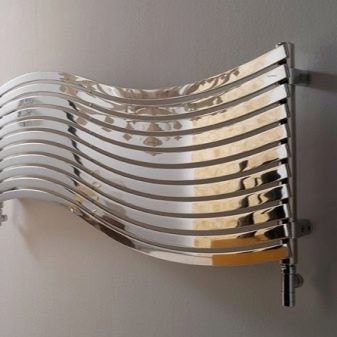
Manufacturers
Electric towel warmers are produced in many countries. They manufacture products of various quality, design and cost. The rating shows that such brands are among the best.
- Kermi - manufacturer from Germany. The products of this brand are distinguished by true German quality.The devices have a reasonable price-performance ratio. Models, usually in the form of a ladder, are made of high quality steel and are characterized by durability, reliability and stylistic versatility.
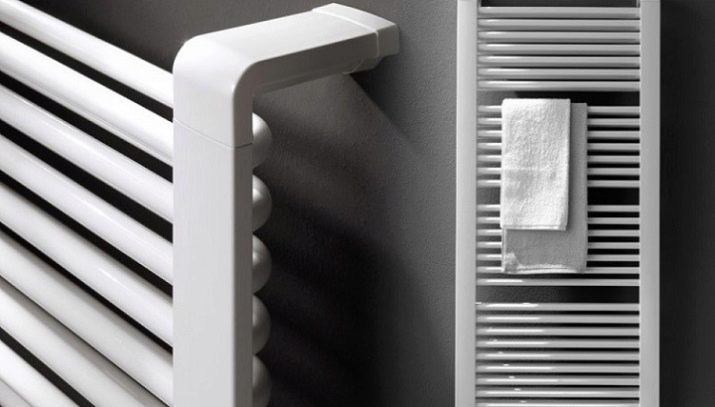
- Arbonia. Heated towel rails from the Swiss manufacturer have a high price. However, it is rightly justified by the high quality and beautiful appearance of the products. The material for their manufacture is high-quality steel. Models are equipped with a mechanism that manually regulates the temperature.
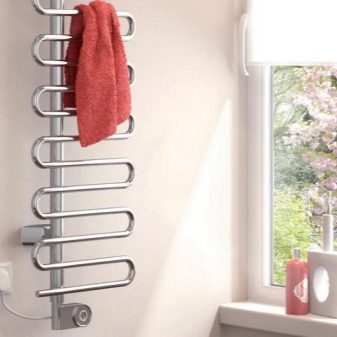
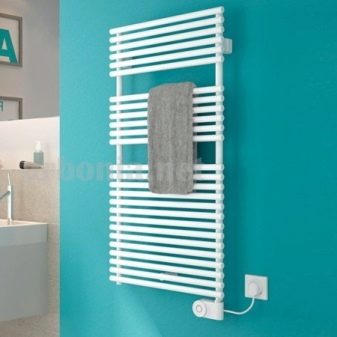
- Margaroli. Products of this brand are also distinguished by their high cost, since they are made of expensive high quality materials and equipped with automatic devices. Their distinctive feature is their elegant design and long service life. They have a very long warranty of 15 years.

- Energy. This company is one of the European leaders in the heating appliance market. Heated towel rails of this brand are characterized by a wide variety of designs and shapes: volumetric and flat, rotary and stationary.
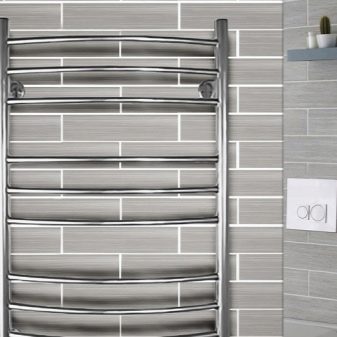
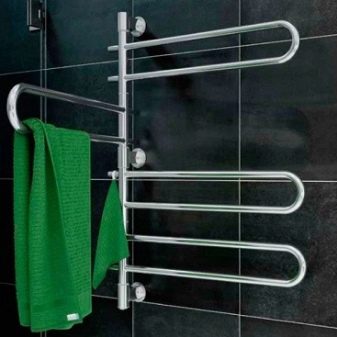
- "Sunerzha". Products of the Russian manufacturer are elite models. They are popular not only in our country, but also in Europe. Models have various designs and are made of stainless steel with a glossy chrome finish.

- "Nika". The company has been producing electric heated towel rails for over 10 years. During this time, its products have gained well-deserved popularity due to their high quality and original design.

In addition to these brands, there are other Russian manufacturers - Dvin, Terminus, Leader-Stal, as well as the Polish Terma.
All of them produce quite high-quality products, both expensive and budgetary.
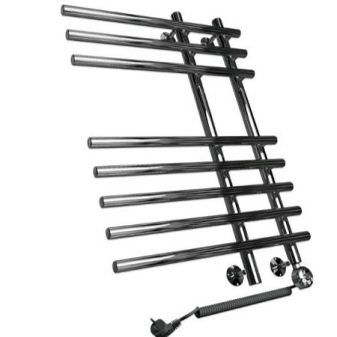
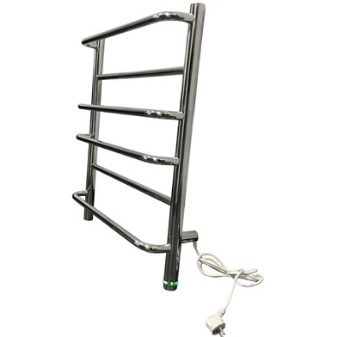
Selection Tips
To correctly select a coil or other type of device, certain characteristics must be considered.
Model power
The power of the devices can be from 30 to 1200 watts. The most common are models with a power of about 300 watts. Coils in the form of a zigzag and letters P, S, S have a power of 100 W. The same power and design devices. At the ladders, the power ranges from 100-300 watts. When choosing a device, you should take into account its intended purpose: a power of 60-80 watts is enough to dry things. If the device is also needed for heating, then the area of the room should be taken into account. A temperature of 22-25 degrees is considered optimal for a bathroom. To achieve this indicator, the model must produce about 100-150 W of heat per 1 sq. m.
With a standard bathroom area the power consumption of the device must be between 560 and 600 W. Units of lower power will not be able to eliminate the humidity in the room, and units that are too powerful consume a lot of electricity.
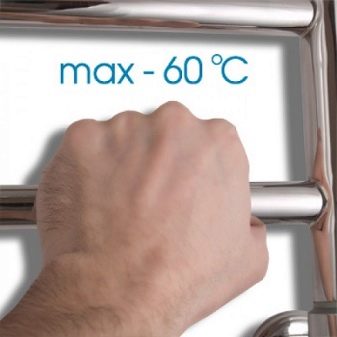

Efficiency and type of heating element
Modern heated towel rails have relatively low energy consumption with a high heat transfer at the same time. But, for models with a heating element in the form of a cable, the power consumption is lower than for oil models.
Liquid models with an oil filler or antifreeze have higher performance, but their power consumption is higher - within 200 watts. Models of different types also differ in the amount of power consumption. When choosing, you should prefer devices with a thermostat, which, by adjusting the temperature regime, thereby save electricity.
The maximum heating temperature of the surface of the unit is usually from 50 to 65 degrees.
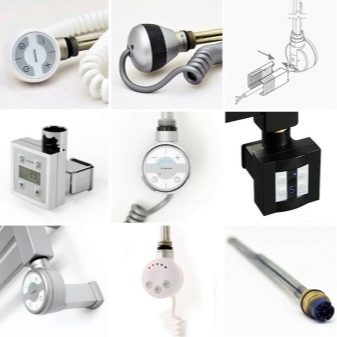
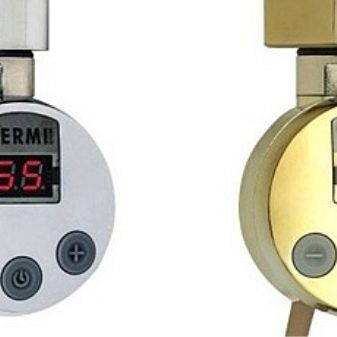
Installation method and design
When choosing a model, you should take into account the size of the bathroom and choose models taking into account its dimensions. You should also provide for the installation site of the unit and the interior of the bathroom. The size and shape of the product will depend on this. When choosing the shape of the model, you need to remember that the more crossbars in it, the greater the heat transfer.
You should also pay attention to the length of the cord.Take into account the distance from the installation site to the outlet so that the cord is not shorter.
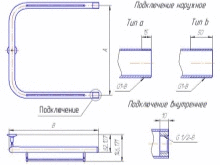
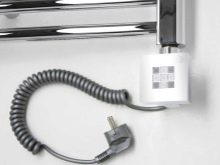
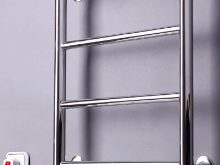
Additional options
Models may have a timer and thermostat and some other options. Such models are more expensive, but they can create additional comfort. Using the timer, it is possible to preheat the bathroom to the desired temperature, and the thermostat will allow you to constantly maintain the temperature in the specified mode. In order not to be mistaken when choosing and buy a good quality device at an affordable price, you should first familiarize yourself with the rating of manufacturers and user reviews.
When buying, it is necessary to thoroughly inspect the device, especially pay attention to the condition of the surface seams. A quality product has a smooth and even seam surface, without roughness, indentations and protrusions. The sections where the cord is connected to the plug and the body must be firmly fixed, and the cord must be flexible and plastic.
The appearance of the device must also be flawless: the painting is even, and the nickel-plated or chrome-plated coating is of high quality.
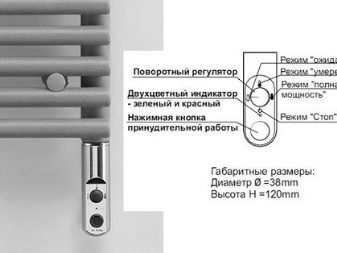
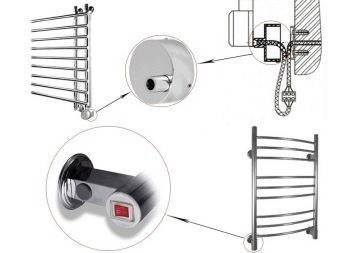
Mounting
There are two ways to connect a heated towel rail to the mains.
- Openwhen electrical wiring is installed directly against the wall and is connected directly to the power source. This is the simplest and easiest way.
- Closed, when the wiring is hidden under the wall finishing material. This is the more difficult but safest way.
Regardless of the design features of bathrooms and appliances, there are general rules for the installation of these units.
- In case of high room humidity and large accumulation of condensation to prevent a short circuit, the socket must be installed not in the bathroom, but in another room. In the bathroom, you can install only a waterproof model of the socket, which is equipped with a protective cover and a rubber seal.
- Socket should be mounted as far as possible from sinks or bathtubs.
- It is recommended to install a residual current device (RCD) in the room, which will stop the supply of current in case of its surges or other accidents.
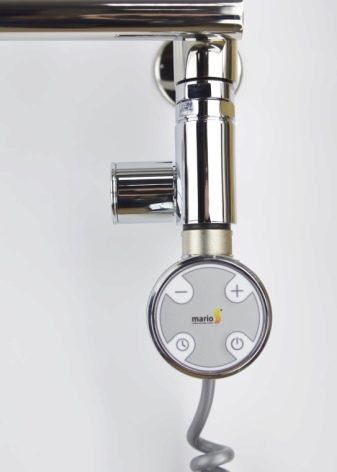
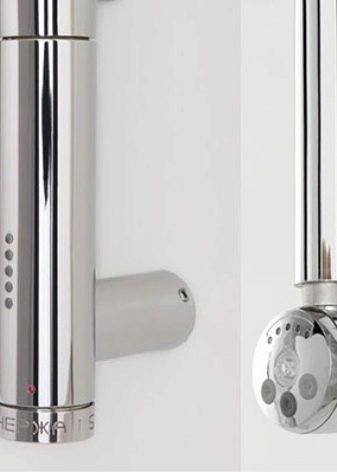
Before installation, it is necessary to take safety measures:
- you can use at work only tools with rubber grips;
- work should be in thick rubber gloves;
- the place of installation of the device must be disconnected from electricity, and the absence of voltage must be checked using a current indicator;
- the room should be absolutely dry.
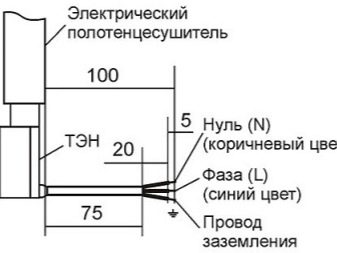

Installation is carried out in this way.
- The installation site is determined and carried out grounding.
- Mounted waterproof socket and RCD.
- On the body of the model are placed brackets.
- With the help of an assistant, you need put the device to the wall, level it and mark the location of the brackets on the wall. Holes for fasteners are made in this place.
- The hole size should be slightly smaller (by about 1 mm), than the diameter of the dowels, and the depth is greater.
- The holes are inserted dowel tips.
- After attaching the device, the brackets are installed on the dowels, which tighten slightly.
This completes the installation and the device can be connected to electricity, but first you need to wait a while (about 10 minutes).
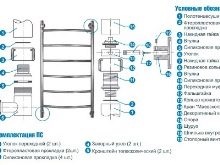
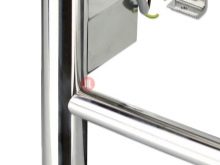
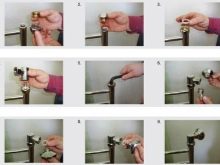
Review overview
A review of customer and user reviews of heated towel rails shows that this device is suitable for its purpose... It is indicated that due to its modern appearance, it can be installed not only in the bathroom, but also in the hallway, corridor, kitchen. If we talk about the device in principle, then most users are satisfied with it: it performs its direct drying function well and heats up the room rather quickly. Parents of young children find it indispensable as it allows a lot of baby clothes to be dried.
There are many positive reviews about individual models of different brands.It is considered positive that the products are small in size, convenient and easy to use and installed quite easily. Negative user reviews in general relate to additional energy consumption during the operation of a heated towel rail. Private negative statements also refer to individual models and indicate such shortcomings: fragility, flaws in the design of the power button, poor-quality assembly and a discrepancy between the real power and the declared one.
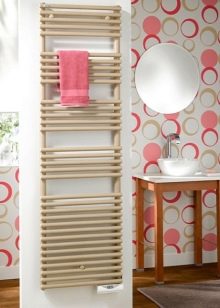
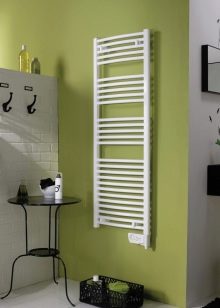

In the next video, you will find the installation of an electric heated towel rail in the bathroom.








